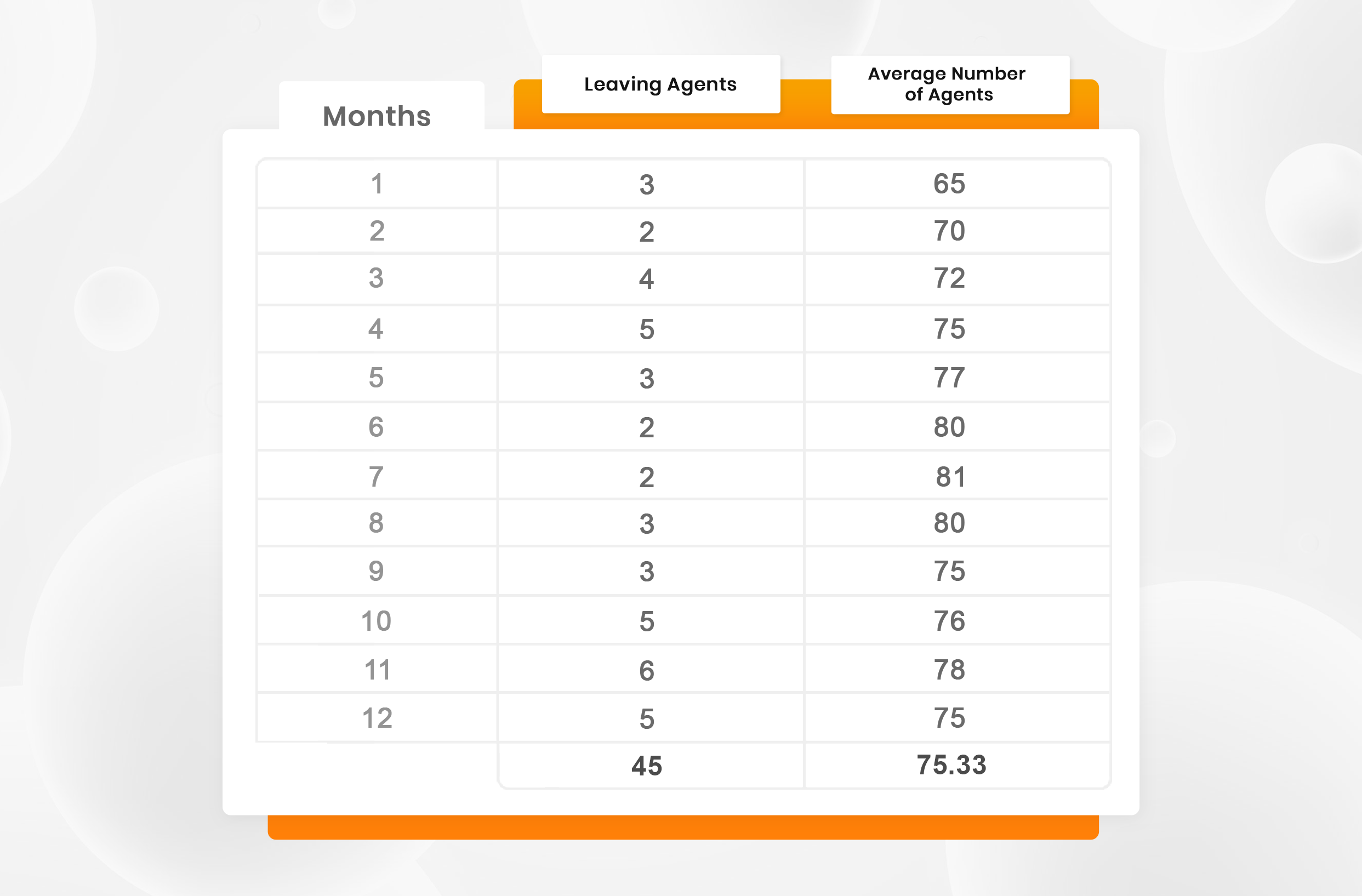This article is a guide to help all the call center operation managers and team leaders out there suffering from high contact center turnover rates.
It’s a handbook on reducing agent turnover and attrition. It’s topped with tips on how to turn your call center agents into brand advocates and best practices from successful contact center operations.
So, without further ado, here is how you can beat the odds and attain happy and efficient employees all year long!
What is an acceptable agent turnover rate in call centers?
The contact center industry is notorious for its high turnover rates. 😔 A QATC (Quality Assurance & Training Connection) study benchmarks the average call center agent turnover rate ranges between 30%-45%. Unfortunately, some contact centers end up experiencing more than a 100% attrition rate until the end of the year.
That is a lot, and I mean a lot of loss for a business. And not only in terms of direct costs like recruitment and hiring expenses but also in terms of secondary costs regarding unproductive training time for new agents and the overtime work your remaining employees need to endure to keep the operation running.
It also has a major effect on customer experience as customers want agents that know your product inside out, which, TBH, is hard to achieve when you have customer service agents come and go.
So, what to do? Keep reading. ⬇️
How can you calculate the turnover rate of your call center?
If you do not know what your turnover rate is, it’s a long shot that you’ll get to improve it. So, it’s math time. 😅
Calculating your turnover rate for the agent workforce will help you start getting to the bottom of things related to your call center operation. It will be a key indicator of your business state, the root cause of many other indicators. So, here’s the formula used by QATC:
Number of leaving agents÷Average number of agents=Annual turnover rate
The year-long scenario in the table below indicates a turnover rate of 57% when you divide the number of leaving agents (43) by the average number of agents (75.33).

Well, what does a business with low turnover rates look like?
According to a Deloitte report (2018), reducing attrition by only 1% can help save $32.9m annually for an organization with 30,000 employees and an average of 13% turnover.
On the other hand, Glassdoor estimates $4,000 cost-per-hire and 24 days of HR and onboarding processes (2019) for each new employee.

Why is there a high turnover in call centers?
The call center attrition benchmarks may be flying through the roof, but we are here to help you beat the odds. Now that you know how to calculate your average call center turnover rate, get ready for some reverse engineering!
All you have to do is conduct exit interviews, look for patterns, analyze attrition rates according to their types, and strategize to make sure you never lose an agent again.
So, read on to discover how to pinpoint what’s driving your agents away and how to lower call center turnover rates for good.
Involuntary turnover
Turnover in call centers isn’t necessarily about agents leaving you—it could be the other way around where you need to lay off significant numbers of agents because of their poor performance.
If you realize a pattern of some sort, that means that you may have a problem with your hiring process and that you’re just recruiting the wrong people in the first place.
What to do?
10 years ago, any person who could answer a phone call was deemed fit to be an agent. And, frankly, call centers weren’t places that people would dream of building a career. Today, all of that has changed.
First of all, with proliferating machine learning and AI-based tools, Super Agents are the new hype. That means you need employees familiar with contact center tech and know their way around terms like UX and CX.
Expand and enrich your interview processes with pre-hire assessments. Ask them to give situational judgment calls during interviews or simplify a complex topic and explain it to you as if you were a child.
Look for signs of how relatable the candidate is to your business or product. Assess their personality—are they calm and understanding, or are they on edge?
You need agents aware of market requirements, modern touchpoints, and emerging trends. Once you hire such talent, don’t forget to appreciate their capabilities and build solid career paths with them.
Talking about contact center tech, did you take a look at Call Center Studio’s next-gen features?
Discover the perfect CCaaS for your Super Agents!
Agent turnover rate by call type
Your contact center can receive calls and queries regarding many different topics (sales, support, returns, etc.). And some of those conversations can be much more stressful and difficult than others.
If you detect a turnover pattern in agents that handle a specific interaction type or subject, you need to look for ways to streamline the process and empower your agents.
What to do?
Every job comes with stress. However, when we’re talking about contact center agents (with long work hours, frustrated customers, targets to hit, etc.), now they experience a whole other level of stress.
And, if you’re not cutting them some slack, providing environments to blow off some steam, or empowering them with the right tools, it’s a matter of time before they find the exit door.
One thing to consider is whether or not you’re utilizing your agents’ capabilities correctly. Some can be best at convincing others (perfect for sales), while some show an admirable level of patience (perfect for after-sales).
You can also allocate more resources to a call group that seems to have harder tasks and alter performance expectations to reduce the stress.
Another thing to remember is that 60% of agents state that their company doesn’t equip them with the right tools to overcome CX challenges.
In such cases, agents feel overwhelmed and burnt out, which only pushes them to quit.
However, if you provide them with steady CRM integrations so they can quickly retrieve customer information, Smart IVR flows that guarantee connecting callers with the best-fit agent and BI tools that boost their productivity, you’ll ensure that they don’t feel incompetent, no matter what the call type is.
Team turnover
You must have heard the saying, “People don’t quit a job—they quit a boss.” While it is a huge pill to swallow, it may be the case for you.
If your calculations indicate a pattern of high turnover rates for a particular group or team, there’s most likely a problem with their supervisor or team leader.
What to do?
In that case, your agents can be leaving, not because of salary expectations or the job itself but because of supervisory issues.
Train your supervisors on leading by example and facilitate team-building exercises to help build a healthy bond between your agents and their supervisors.
Another big mistake businesses tend to make is valuing supervisors more than agents. Agents may be referred to as frontline employees, but they’re actually the backbone of your call center, keeping your operations running. When you underestimate the position you’re hiring them for, it’s only fair that they end up ignoring the job and their responsibilities.
Define your goals, whether improving customer service levels or increasing sales, and acknowledge that your agents are most likely the only ones that can make that happen.

Contact Center turnover rate by training
If an agent feels alienated from your corporate culture, product, or service and lacks the required knowledge, they are bound to feel like an outsider and start looking for a way out.
What to do?
Training is the best way to keep your agents up-to-date and related to your processes. So, here are some training types you may be overlooking.
The perfect training for onboarding must comprise:
- Contact center software and hardware
- Customer profile
- Product information
- Corporate rules and culture
- Collaborative departments
On the other hand, you need regular training, which is often ignored by many businesses. These training sessions can include information on:
- Contact center software and hardware updates
- New product(s)/product features
- Frequent customer pain points
- Soft skills training
- Emerging trends
- Best practices
Don’t hesitate to track your agents’ performance and create specific training programs according to their expectations and requirements.
Contact center turnover rate by salary
The US salary average for a call center representative is $31,056/yr (Glassdoor). When you think of how stressful and hectic their job can get, you’d also get why agents could be unsatisfied and seek other options.
What to do?
Paying your agents even a little above the industry average can go a long way, setting you apart from all the other customary contact centers where many agents feel their efforts are not appreciated enough.
Can’t pay more? Offer different perks and benefits to motivate employees. You would be surprised how one corporate tradition can fuel your agents into becoming brand advocates.
For instance, a global BPO RDI has an effective solution to promote employee wellness and offer agents a reason to stick around.
They create virtual monthly fitness challenges where hundreds of agents join and bond.
Another great example of best practices for employee retention would be MassMutual.
This financial service provider created a gamification program where agents collect points for certain KPIs such as AHT (Average Handle Time) and schedule adherence.
The best part is, agents can use these points to buy things from MassMutual’s marketplace and get them shipped to their homes as they are now WFH cause of the pandemic.
Need a budget-friendly, cost-efficient contact center solution to allocate more budget for your employees? How about a scalable cloud-native CCaaS that offers multi-tenancy and colocation and requires no maintenance fee, no license renewals, and no bulky hardware?
Say hi to Call Center Studio!
Call Center Studio is here to have your back!
We hope that you and your employees get to find the perfect harmony and achieve years of success together.
At Call Center Studio, we want to make sure you do so. Thus, we considered what you, your customers, and your agents need to have the best contact center experience ever and created a CCaaS that offers:
- Easy onboarding to facilitate your hiring processes,
- Robust tools to unleash your agents’ full potential,
- UX-friendly dashboards to simplify your agents’ tasks, and
- Multiple touchpoints and steady integrations for quality customer interactions.
Contact us to learn more about how Call Center Studio can help you make a mark in the industry and help you become agents’ and customers’ favorite!




